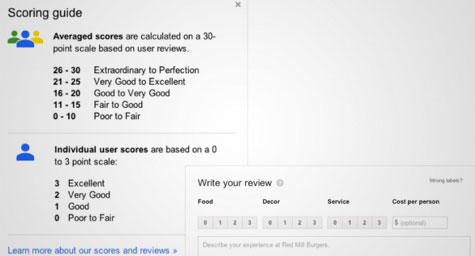Google Places Pages Entirely Replaced by Google+ Local Pages. How Will This Affect Your Business?


Google+ has replaced the most prolific and prominent local search-marketing vehicle ever created. What was once Google Places is now Google+ Local. Or maybe it’s +Local? Local+? Who knows what the official title will be once this all plays out. What we do know is that local search has come a long way since the original local search ecosystem was released.
The change officially took place on May 30, when in a matter of hours, all local results in SERPs suddenly became known as Plus. No amount of “+1-ing” your own listing or begging your friends/customers to +1 your products and services will help you get ahead or take advantage of this shift, because Google made the call—on your behalf—to make Zagat ratings the ultimate ranking scale of your business’s awesome factor.
The substitution of Google Places by Google+ Local has left many webmasters confused—or just plain dumbfounded—that local search has now gone completely social. Why is that? Well, because Google wants you, the consumer, to have more control over how you express your thoughts about local businesses on Google+.
Greg Sterling of Search Engine Land wrote one of the most detailed articles about the new Google+ Local features. In the article , Sterling provides a tour of the new platform and its features—something that other bloggers are essentially recycling as everyone seeks to understand the system and position themselves as “experts” in understanding how to fully leverage the system’s capabilities. Sterling cited the following as the most prominent changes that took place during the platform’s shift:
• The substitution of the new Google+ Local pages for Google Places pages
• The appearance of a “Local” tab within Google+
• The integration and free availability of Zagat reviews (its entire archive)
• The integration of Google+ Local pages across Google properties (search, Maps, mobile)
• Integration of a circles filter to find reviews/recommendations from friends/family/colleagues
While the shift will likely be positive for business owners in the long run, adapting to the change may take some patience. Whether you like it or not, if you relied on Google Places for traffic or credibility in a sea of competitors, you’ll need to embrace Google+ for all it’s worth. At this point, not using Google+ in the context of local search could seriously diminish your local visibility.
Despite the normal cynicism from the SEO community that erupted over the change—which comes on the heels of the infamous Penguin and Panda 3.3 updates—Google+ Local actually has some slick features that can provide a much-needed refresher for your dull Places page. Management of your Google+ Local profile is still carried out through Google Places at this time, but that could change any day, at any minute. The best thing to do is look to online marketing veterans who pour themselves into learning as much about the Google-verse as possible.
One of the all-stars of the local search world, David Mihm, is at the forefront of chronicling the change and detailing how business owners can adapt to the Plus takeover of Google Places. Mihm chronicled the Plus-Places merge in detail, offering tremendous insight into the nuances of the shift and what business owners can expect when it comes to adapting to the platform. He pointedly cited that Google is attempting to use businesses as a means to lure (or force) users to adopt Plus. This is certainly in line with the all-out assault Google made on the marketing community less than a year ago, driving a media blitz that terrified marketers into using Plus or risk being forgotten in the SERPs.
While there are likely a dozen or more changes on the way for this new system, the core of it compounds the voices of users, providing a more detailed “ranking/rating” scale based on Zagat’s 30-point system. This is a step up from the star-based ratings that previously existed, but essentially obfuscates the voices of users or other factors that may contribute to rating an establishment’s true “worth.” Unfortunately, the new rating scale, pictured below, uses arbitrary language—Poor to fair? Fair to good? Good?—that really doesn’t help people understand anything about the business itself:

One thing about user reviews, ratings, and the myriad of other scoring factors used by people to classify their favorite local businesses is that a good percentage of the reviews on Google Places are written by strangers whose tastes and thresholds for quality may be completely different from yours. That’s what Google+ Local attempts to solve: blending the opinions of your friends/circles into reviews you can trust, along with those of the dozens of digital friends you’ve made on Google+. But the problem is, are you actually using Google+? Is anyone you know using Google+? The answer is, probably not. It’s unfortunate that reviews for your favorite restaurants, hotels, or shops are now being driven by that .000003% of the population who actively use Google+. So if you want to refute a bad review or write one yourself, you have to be a Google+ member. +1 for Google!
It’s no mystery as to what Google stands to gain from leveraging an implicit social link graph, especially in the context of local search: another opportunity to serve super click-worthy geotargeted and user-specific ads across a microtargeted social medium. Still, as a business owner, leveraging local results with a powerful visual element is a major area of opportunity to earn new customers, and though it may not be time for you to start launching monotonous hangouts on Google+, it is time for you to start making your Google+ Local page a lot more visual.
The first step is to claim your business listing. Make sure you own it and can access it directly. If you haven’t set up a Google Plus Business page, do it now. Fill out everything they allow you to, post your best pictures and videos, write about how awesome you are, and add as much depth to the profile as possible. Create coupons, offers, and incentives—now is the time to get ahead of your competitors while they struggle to log in to their newly acquired Google+ Places account. If pictures were previously worth a thousand words, they’re now worth about a hundred thousand today! Add as many high-quality photos as possible to your profile and don’t stop there; start taking pictures of customers—or whatever it is that you do to sell what you’ve got—and continue to place them in your Google+ Local profile.
The hard part will be convincing your patrons to write reviews on the new system, since they must be Google+ members to author and publish something. And get ready—Google+ Local makes it possible for businesses to review other businesses, so now your competition can write about you, too.
Over the next few weeks, a plethora of resource articles and handy guides will emerge, since the local business marketing space is literally ablaze with commentary about this shift. Try to stay focused and read as much as you can while not abandoning the traditional Places marketing tactics you’ve used in the past. It’s hard to imagine that Google would disable Places management in favor of a centralized management system through Google+ Local just yet, but be prepared.
For more information on the shift, here’s a consolidated list of the most helpful links:
- http://googleandyourbusiness.blogspot.com/2012/05/helping-people-discover-and-share-local.html
- http://www.davidmihm.com/blog/google/plus-places-merge-here/
- http://blumenthals.com/blog/2012/05/30/google-places-pages-are-no-more-but-what-has-changed/
- http://www.smallbusinesssem.com/google-places-marries-google-gives-birth-to-new-google-local-pages/5828/
- http://www.davidmihm.com/blog/google/local-plus-rankings/
MDG can help you navigate through the new Google changes and create a strategy that works for your business goals. To learn more about Google+ Local and the power of local search, contact MDG today at 561-338-7797 or visit www.mdgsolutions.com.
